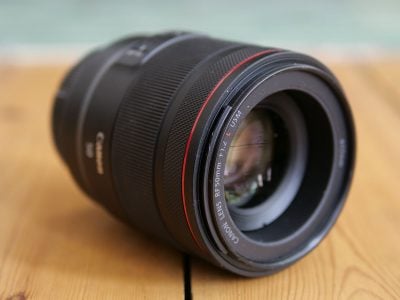Canon RF 50mm f1.2L USM review
-
-
Written by Gordon Laing
Quality
To compare the sharpness of the Canon RF 50mm f1.2L USM against the EF 50mm f1.2L USM, I shot this scene with both lenses mounted in-turn on a Canon EOS R body, the EF version fited via the Canon adapter. I then captured JPEG and RAW files with each lens at each aperture value, and have presented crops from processed RAW files below. I processed the RAW files in Adobe Camera RAW without any lens profile applied (at the time I tested, the EOS R was supported by ACR, but a profile for the RF 50mm had not been added). I took two crops from each image, one from near the upper left corner and the other from near to the middle, indicated by the red rectangles. The crops are presented at 100% in the columns below with the new RF version on the left and the older EF version on the right.

Judging from the crops below, there are quite clear differences between the optical quality of the RF and EF lenses on test. Most obviously, the newer RF version is noticeably sharper in the corners than the older EF version at large apertures; indeed the RF 50mm f1.2L USM remains sharper in the corners throughout most of the aperture range and only allows the EF version to eventually catch up at the smallest apertures when diffraction is actually making them softer.
Looking at the grating across the window also reveals the newer RF version enjoys much squarer geometry whereas the older EF version is exhibiting quite obvious barrel distortion; this is particularly noticeable when you see the entire image, but can even be seen on these small crops. Meanwhile both lenses, as is typical for bright aperture models, exhibit quite noticeable vignetting / darkening in the corners at the smallest f-numbers.
If you apply lens profile corrections, the vignetting on both models is mostly cleared-up, and the geometric barrel distortion of the older EF version is greatly improved (albeit at the cost of wrangled pixels and potential resolution loss), but profiles can’t do anything to improve the sharpness in the corners of the EF model. This is an area where the new RF 50mm f1.2L USM takes a comfortable lead, delivering noticeably sharper results right into the corners even at the largest apertures. And again the virtual absence of barrel distortion means there’s no need for geometric correction with its potential loss in resolution; note I’m not ruling-out the possibility that Canon has baked some corrections into the RF lenses at a low level which can’t be turned on or off, but the fact is the new RF 50mm f1.2L USM is delivering more detail, higher resolution and greater contrast as tested here even after any possible low-level corrections (if any) have taken place.
Moving onto the centre crops, you’ll notice the RF 50mm f1.2L USM is crisper overall and higher contrast too. In addition look at the torn white sticker on the drain pipe on the right side with the black zig-zagging line: on the older EF lens there’s evidence of chromatic aberrations / fringing and low contrast, whereas on the newer RF version, it’s crisp, contrasty and fringe-free.
In short, the RF 50mm f1.2L USM may deliver similar rendering to the earlier EF 50mm f1.2L USM (as shown on the previous page) but it’s much better-corrected with sharper details across the frame and especially in the corners, sports lower geometric distortion and less fringing too. It’s noticeably superior in these regards, although if you’re mostly shooting portraits near the centre of the frame with creamy blurred backgrounds, you won’t enjoy all the benefits of the new model.
Next check out my gallery of sample images or head to my verdict using the tabs at the top of the page of links at the bottom.
Canon RF 50mm f1.2 vs EF 50mm f1.2: corner sharpness. No corrections.

Above left: RF 50mm f1.2. Above right: EF 50mm f1.2. 100% crops from corners at f1.2.

Above left: RF 50mm f1.2. Above right: EF 50mm f1.2. 100% crops from corners at f1.4.

Above left: RF 50mm f1.2. Above right: EF 50mm f1.2. 100% crops from corners at f2.

Above left: RF 50mm f1.2. Above right: EF 50mm f1.2. 100% crops from corners at f2.8.

Above left: RF 50mm f1.2. Above right: EF 50mm f1.2. 100% crops from corners at f4.

Above left: RF 50mm f1.2. Above right: EF 50mm f1.2. 100% crops from corners at f5.6.

Above left: RF 50mm f1.2. Above right: EF 50mm f1.2. 100% crops from corners at f8.

Above left: RF 50mm f1.2. Above right: EF 50mm f1.2. 100% crops from corners at f11.

Above left: RF 50mm f1.2. Above right: EF 50mm f1.2. 100% crops from corners at f16.
Canon RF 50mm f1.2 vs EF 50mm f1.2: centre sharpness. No corrections.

Above left: RF 50mm f1.2. Above right: EF 50mm f1.2. 100% crops from centre at f1.2.

Above left: RF 50mm f1.2. Above right: EF 50mm f1.2. 100% crops from centre at f1.4.

Above left: RF 50mm f1.2. Above right: EF 50mm f1.2. 100% crops from centre at f2.

Above left: RF 50mm f1.2. Above right: EF 50mm f1.2. 100% crops from centre at f2.8.

Above left: RF 50mm f1.2. Above right: EF 50mm f1.2. 100% crops from centre at f4.

Above left: RF 50mm f1.2. Above right: EF 50mm f1.2. 100% crops from centre at f5.6.

Above left: RF 50mm f1.2. Above right: EF 50mm f1.2. 100% crops from centre at f8.

Above left: RF 50mm f1.2. Above right: EF 50mm f1.2. 100% crops from centre at f11.

Above left: RF 50mm f1.2. Above right: EF 50mm f1.2. 100% crops from centre at f16.
Check prices on the Canon RF 50mm f1.2L at Amazon, B&H, Adorama, or Wex. Alternatively get yourself a copy of my In Camera book or treat me to a coffee! Thanks!




